Key Points:
- The official coldest recorded temperature in Wisconsin was -55 degrees Fahrenheit in the Village of Couderay.
- According to a compilation of 30-year averages by the National Oceanic and Atmospheric Administration (NOAA), Eau Claire is the coldest place in Wisconsin. It has an average low temperature of 11.9 degrees Fahrenheit.
- Green Bay, Appleton, La Crosse, and Oshkosh are close competitors, with average lows ranging from 14.6 to 15.5 degrees Fahrenheit.
Wisconsin is one of the coldest regions in the United States. The absolute coldest places in the continental United States are Alaska, Minnesota, Wisconsin, North Dakota, and South Dakota.
The upper midwestern states and Alaska all host a number of the coldest cities in the country. According to data from the NOAA, Eau Claire takes the “most frigid” title for the state of Wisconsin.
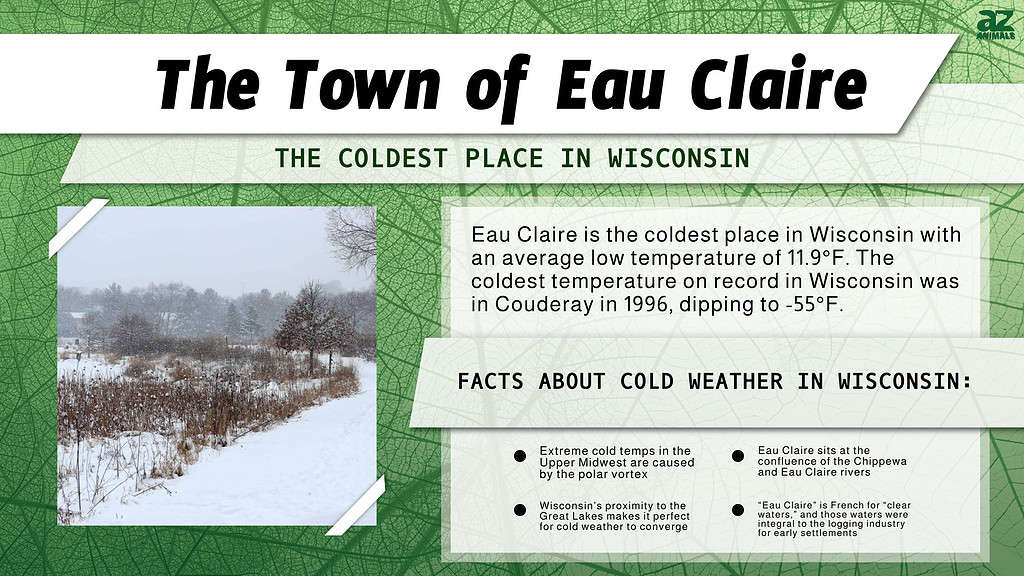
The University of Wisconsin-Eau Claire hosts arguably the city’s coldest spot—a walking bridge over the Chippewa River. Temperatures get dangerously low there, affecting bundled students crossing the bridge on their way to class.
Let’s take a deeper look at Eau Claire, exploring what makes it so cold and learning about its history. But first, let’s pay tribute to the coldest-recorded moment in Wisconsin’s history.
Wisconsin’s Record Low: The Village of Couderay

Northern Wisconsin is one of the coldest places in the United States.
©Charles Collard/Shutterstock.com
Wisconsin’s coldest event took place north of Eau Claire on the outskirts of the Chequamegon National Forest in Couderay Village. The population here is lower than 1,000 people. Interestingly, Al Capone found this remote location the perfect place for one of his north woods’ getaway homes.
In the Winter of 1996, decades after Capone lived there, a cold streak swept through Wisconsin. The lowest recorded temperature in Couderay on February 2nd of that year was -55 degrees Fahrenheit.
That number still holds among the coldest temperatures recorded in American history. It’s just 15 degrees warmer than the national record of -70 in Rogers Pass, Montana.
Why Is the Midwest So Cold?
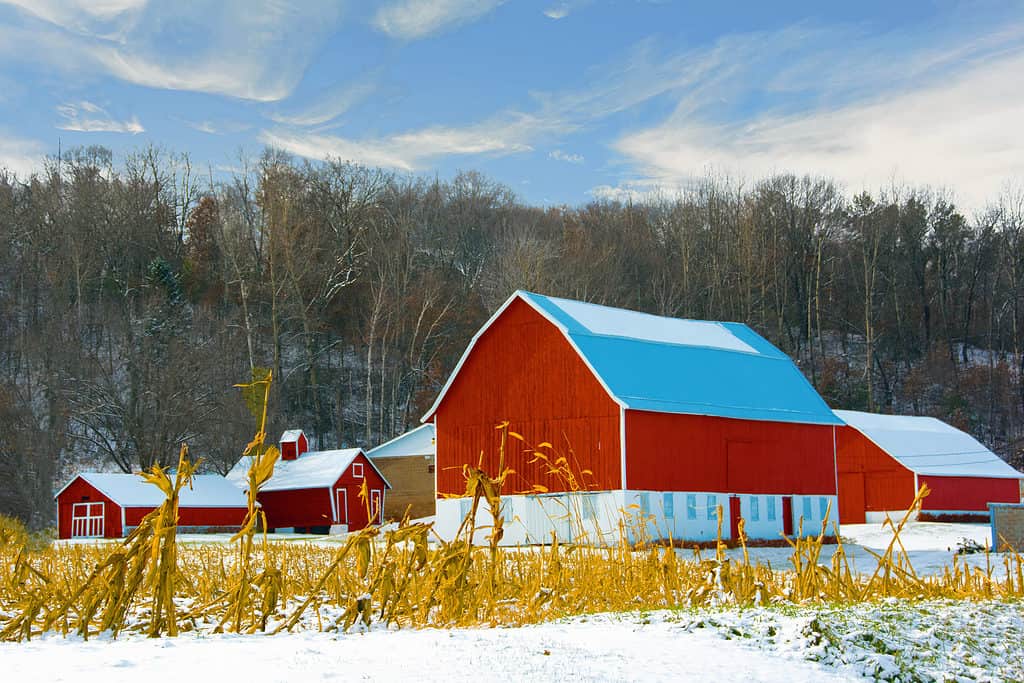
When freezing air travels into North America, areas like Eau Claire in the Midwest are hit the hardest.
©iStock.com/William Reagan
Eau Claire gets extremely cold for a few key reasons.
The first is that it’s situated in the heart of the Upper Midwest. This region frequently gets so cold that officials advise people to “avoid taking deep breaths” while they’re outside.
Most of the extreme cold snaps in the Midwest are caused by a polar vortex. This is a collection of swirling low-pressure winds high in the stratosphere, lingering upwards of 30 miles into the air.
As the name suggests, there are vortexes above both of the earth’s poles. However, the activity of the vortex at the south pole doesn’t affect most people.
A wind called the polar jet stream surrounds the northern polar vortex. While the vortex is roughly 10-30 miles above the surface, the jet stream is five to nine miles above the surface. The lower polar jet stream corrals the vortex.
This relationship, when undisturbed, keeps freezing temperatures above the North Pole.
Every couple of years, the jet stream-vortex relationship weakens due to various factors. In many cases, warm air travels northward and disrupts the uniform rotation of the polar jet stream. The jet stream weaves up and down along its path and loosens its constraint on the polar vortex.
If you think of the polar vortex as a spinning top, imagine how it topples when it stops spinning. Cold air falls south like an icy monster. Sometimes, it even splits into two parts and freezes northerners in different parts of the world simultaneously.
When it travels into North America, the Midwest is hit the hardest. The Rocky Mountain Range funnels the weather east. The cold air sinks down into the low elevation of the upper midwest, where it runs over the Great Lakes producing snow. It doesn’t help that much of the Midwest is flat, with no barriers to stop the rushing wind.
Why Is Eau Claire the Coldest Place in WI?

Windchill is a large factor in Wisconsin due to the flat topography of the state.
©iStock.com/4u4me
Aside from large-scale factors like polar vortexes, Eau Claire is particularly cold due to its precise location. It sits at the confluence of the Chippewa and Eau Claire rivers. The Chippewa River, which runs northeast, skirts the Upper Peninsula of Michigan south of Lake Superior.
The full Chippewa Valley stretches across northwestern Wisconsin, sheltered by a wall of higher elevation to the west. That high-elevation area causes cold weather from the Great Lakes to run down the valley. It finds its lowest point in Eau Claire.
There’s a similar situation in La Crosse, WI. A large wall of higher-elevation land funnels cold weather from Lake Michigan down into the La Crosse River valley.
Wisconsin’s proximity to the Great Lakes makes it the perfect place for cold weather to converge. That’s why this state is home to so many extremely cold places.
Where Is Eau Claire Located on a Map?
Eau Claire is primarily situated in Eau Claire County, of which it is the county seat, with a small area of the city located in Chippewa County. It is around 90 miles east of Minneapolis and St. Paul, Minnesota.
Biggest Blizzard in Wisconsin History
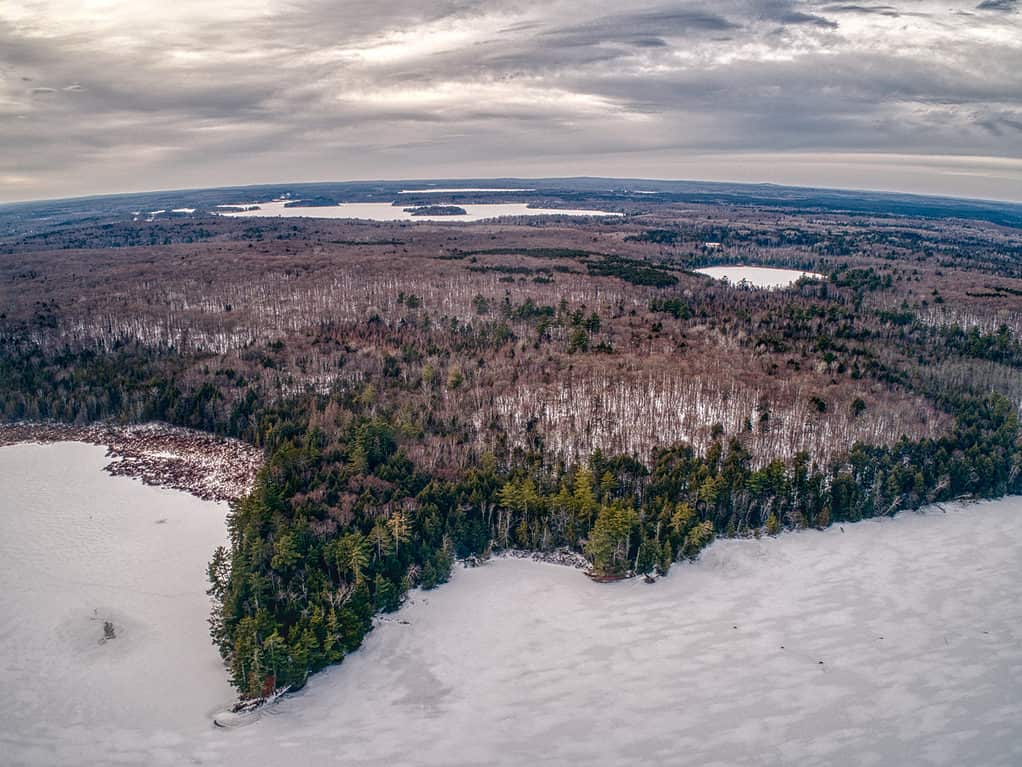
Wisconsin experienced 40-foot snow drifts during the blizzard of 1881.
©iStock.com/Jacob Boomsma
The blizzard of March 1881 brought immense amounts of snow to Wisconsin, with drifts reaching up to 40 feet in some areas. This was the worst snowstorm ever recorded in the state’s history, and it completely shut down all railroad traffic and any other form of travel on roads or streets. In addition to this, many homes were destroyed as a result of the strong winds that accompanied these blizzards. Furthermore, animals such as livestock were also killed due to their inability to cope with such extreme weather conditions. This event is remembered by locals as one of the most devastating natural disasters in Wisconsin’s history.
The History and Culture of Eau Claire
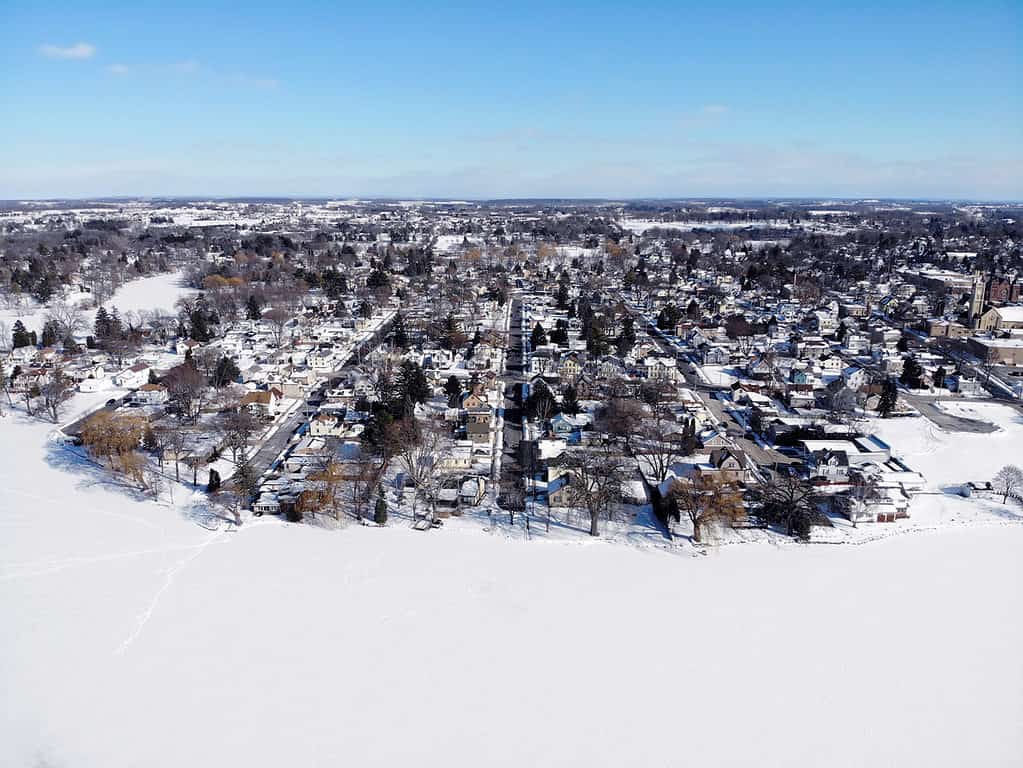
Wisconsin is close to the Great Lakes and bad weather often lands there.
©iStock.com/quinntheislander
The region of Eau Claire sits on the traditional lands of the Ojibwe, Dakota, and Ho-Chunk. The first European settlers chose the location in 1845 and quickly turned it into an important logging hub.
“Eau Claire” is French for “clear waters,” and those waters were integral to the logging industry for those early settlements. After the logging industry lost its value for Eau Claire, the population shifted gears toward manufacturing and production. The University of Eau Claire opened in 1916 and has since served as a central draw for the city.
Eau Claire is also home to Chippewa Valley Technical College. The existence of those two schools, alongside myriad manufacturing opportunities, has turned the city into a thriving place. Larger than a small town but smaller than a city, Eau Claire is a community-minded and enjoyable place to live.
It’s also home to Grammy-award-winning artist Bon Iver, who created the Eaux Claires Music Festival for the community. Eau Claire also hosts popular festivals, such as Country Fest and the Blue Ox Bluegrass Festival. Both festivals draw thousands of people from surrounding metropolises.
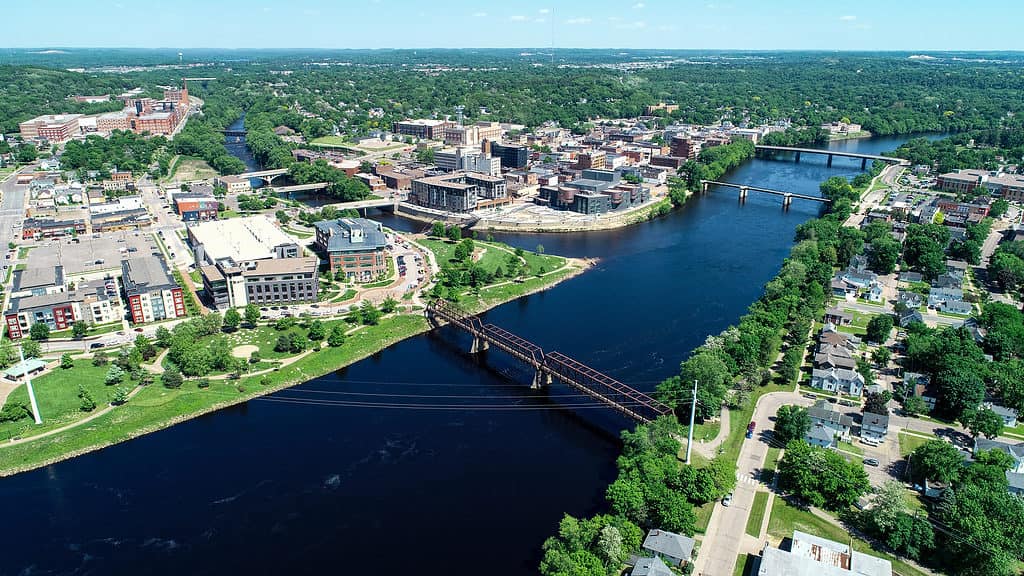
Eau Claire was founded in 1845 and has a rich culture and history.
©Matthew A Reddy/Shutterstock.com
Wildlife in Eau Claire
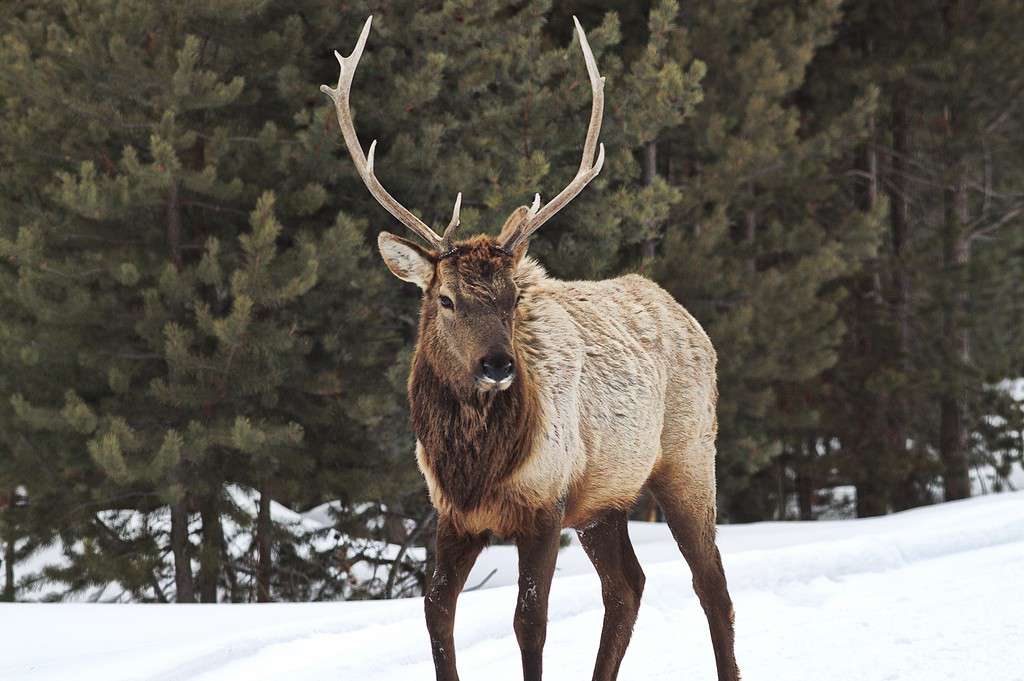
©Debeo Morium / CC BY-SA 3.0 – License
While Wisconsin is better known for its cheese than for its animals, it’s home to a surprising variety of species. In fact, the diversity of wildlife in western Wisconsin might surprise you.
As a result of the unique geography, a diversity of wildlife survives and thrives throughout the region. John Steinbeck once wrote a piece on the Wisconsin landscape. He called it a “weird country sculpted by the Ice Age, a strange, gleaming country of water and carved rock, black and green.”
You’ll find everything from Elk to Whooping cranes nestled into those Ice Age hills and valleys. The most common large mammal you’ll see in Wisconsin is the white-tailed deer.
It’s also possible to see cougars, bears, wolves, and the occasional moose, but those are particularly rare. More common are the “furbearers,” who are a little smaller but just as interesting. Wisconsin furbearers are animals that you might not see anywhere else.
There are common animals like the coyote and rarer inhabitants like the red and grey foxes. There are also river otters, beavers, fishers, badgers, American pine martens, minks, weasels, muskrats, bobcats, and lynx.
There’s also a thriving diversity of birds in Eau Claire. You’ll see anything from owls to swans and turkeys to bald eagles. Further, the region is notable for its fish population and myriad of lakes.
Try not to visit in the dead of winter, and your visit to Eau Claire will be unforgettable!
The photo featured at the top of this post is © MarynaG/Shutterstock.com
Sources
- DNR, Available here: https://dnr.wisconsin.gov/topic/wildlifehabitat/Wisconsin_animals
- SciJinks, Available here: https://scijinks.gov/polar-vortex/
- National Oceanic and Atmospheric Administration, Available here: https://data.noaa.gov/onestop/
- Niche, Available here: https://www.niche.com/blog/top-50-coldest-cities-in-america/
Thank you for reading! Have some feedback for us? Contact the AZ Animals editorial team.






